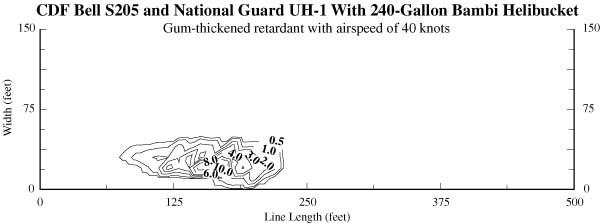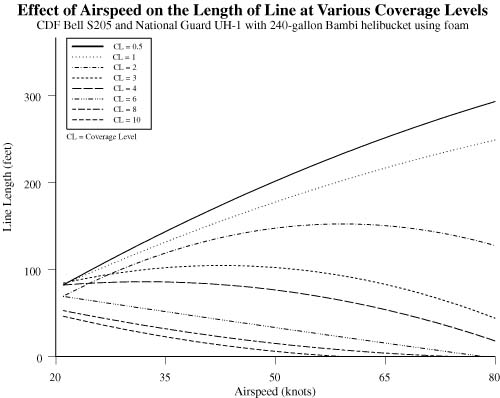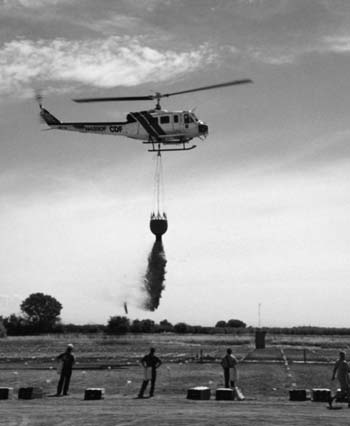

The Wildland Fire Chemical Systems (WFCS) Program tests a variety of fixed- and rotary-wing airtankers to determine the parameters for optimal ground-pattern coverage over a wide range of fuel and fire conditions. The CDF Bell S205 helicopter (operated by the California Department of Forestry and Fire Protection) and the National Guard Bell UH-1 Iroquois Huey (operated by the National Guard) were tested with the 240-gallon SEI Industries Bambi helibucket. Both helicopters (referred to as the CDF Bell S205 and National Guard UH-1 with 240-gallon Bambi helibucket) belong to a family of helicopters designed for fire suppression with the use of a helibucket. They qualified as Type 2 helicopters.
The Bambi helibucket is constructed of a heavy, coated fabric mounted to a collapsible frame (figure 1). The dump valve (16 inches in diameter) is electrically actuated from the helicopter using 28 volts dc aircraft power. The helibucket's maximum volume is 240 gallons with a maximum fill height of 38 inches. The volume of a given drop can be controlled by the rate at which the helibucket is lifted from the water (faster lift produces more volume) or by adjusting a cinch strap inside the helibucket.
 |
| Figure 1-The CDF Bell S205 with 240-gallon Bambi helibucket. |
The Missoula Technology and Development Center tested the CDF Bell S205 and National Guard UH-1 with 240-gallon Bambi helibucket using a series of drops over an array of plastic bowls much like Cool Whip containers. The quantity of material in each bowl was measured and the data were used to determine the drop pattern.
Tests included airspeeds from 18 to 84 knots (21 to 97 miles per hour) and drop heights from 27 to 86 feet from the bottom of the tank to the ground. The drops were made with three different materials: water, foam, and gum-thickened retardant.
Flow rate, drop height, and airspeed all affect the drop pattern. Because this type of helicopter is normally used over a narrow range of heights and speeds and because this system produces a single flow rate, information about an average drop is presented. Figures 2, 3, and 4 show the effect of material dropped with airspeeds of 37 to 40 knots (43 to 46 miles per hour) and drop heights ranging from 38 to 50 feet using water, foam, and gum-thickened retardant.
 |
| Figure 2-Drop pattern characteristics for the CDF Bell S205 and National Guard UH-1 with 240-gallon Bambi helibucket using water at an airspeed of 38 knots (44 miles per hour) and a drop height of 42 feet. The contour lines are at coverage levels of 0.5, 1, 2, 3, 4, 6, 8, and 10 gallons per 100 square feet. |
 |
| Figure 3-Drop pattern characteristics for the CDF Bell S205 and National Guard UH-1 with 240-gallon Bambi helibucket using foam at an airspeed of 37 knots (43 miles per hour) and a drop height of 38 feet. The contour lines are at coverage levels of 0.5, 1, 2, 3, 4, 6, 8, and 10 gallons per 100 square feet. |
 |
| Figure 4-Drop pattern characteristics for the CDF Bell S205 and National Guard UH-1 with 240-gallon Bambi helibucket using gum-thickened retardant at an airspeed of 40 knots (46 miles per hour) and a drop height of 50 feet. The contour lines are at coverage levels of 0.5, 1, 2, 3, 4, 6, 8, and 10 gallons per 100 square feet. |
The proper amount of fire-retarding materials to be applied (expressed as coverage level in gallons per 100 square feet) differs depending on the fuel model. Table 1 shows the coverage needed for specific fuel models using both the National Fire Danger Rating System (NFDRS) and Fire Behavior Fuel Model descriptions.
Table 1-The retardant coverage needed for specific fuel types.
| Fuel Model | |||
|---|---|---|---|
| National Fire Danger Rating System (NFDRS) | Fire Behavior | Coverage Level (gal/100 sq. ft) | Description |
| A, L, S | 1 | 1 | Annual and perennial western grasses, tundra |
| C | 2 | Conifer with grass | |
| H, R | 8 | 2 | Shortneedle closed conifer; summer hardwood |
| E, P, U | 9 | Longneedle conifer; fall hardwood |
|
| T | 2 | Sagebrush with grass | |
| N | 3 | Sawgrass | |
| F | 5 | 3 | Intermediate brush (green) |
| K | 11 | Light slash | |
| G | 10 | 4 | Shortneedle conifer (heavy dead litter) |
| O | 4 | Southern rough | |
| F, Q | 6 | 6 | Intermediate brush (cured), Alaska black spruce |
| B, O | 4 | California mixed chaparral, high pocosin |
|
| J | 12 | Greater than 6 | Medium slash |
| I | 13 | Heavy slash | |
The results of drop tests allow managers to estimate the length of line a specific airtanker produces at various coverage levels. Table 2 or figure 5 can be used to determine the airspeed required to obtain the longest line of water at each coverage level. Table 3 or figure 6 can be used to determine the airspeed required to obtain the longest line of foam at each coverage level. Table 4 or figure 7 can be used to determine the airspeed required to obtain the longest line of gum-thickened retardant at each coverage level.
Table 2-Water tests producing the longest line at various coverage levels.
| Coverage Level (gal/100 sq. ft) | Line Length (feet) |
Airspeed (knots) |
|---|---|---|
| 0.5 | 288 | 76 |
| 1 | 262 | 76 |
| 2 | 173 | 44 |
| 3 | 128 | 38 |
| 4 | 117 | 38 |
| 6 | 68 | 18 |
| 8 | 64 | 18 |
| 10 | 59 | 18 |
 |
| Figure 5-Use this graph to estimate the drop height needed to provide the longest line of water at various coverage levels. |
Table 3-Foam tests producing the longest line at various coverage levels.
| Coverage Level (gal/100 sq. ft) | Line Length (feet) |
Airspeed (knots) |
|---|---|---|
| 0.5 | 333 | 78 |
| 1 | 285 | 78 |
| 2 | 180 | 78 |
| 3 | 125 | 37 |
| 4 | 117 | 37 |
| 6 | 83 | 37 |
| 8 | 61 | 37 |
| 10 | 48 | 37 |
 |
| Figure 6-Use this graph to estimate the drop height needed to provide the longest line of foam at various coverage levels. |
Table 4-Gum-thickened retardant tests producing the longest line at various coverage levels.
| Coverage Level (gal/100 sq. ft) | Line Length (feet) |
Airspeed (knots) |
|---|---|---|
| 0.5 | 292 | 82 |
| 1 | 253 | 82 |
| 2 | 220 | 82 |
| 3 | 115 | 55 |
| 4 | 94 | 38 |
| 6 | 68 | 38 |
| 8 | 42 | 25 |
| 10 | 19 | 25 |
 |
| Figure 7-Use this graph to estimate the drop height needed to provide the longest line of gum-thickened retardant at various coverage levels. |
The line-length graphs predict line length (in feet) as a function of airspeed (in knots). The tables are constructed by selecting the drop producing the longest line at each coverage level. Either the graphs or tables may be used to estimate the airspeed required to produce the longest line for a given coverage level. The tables show an ideal case, while the graphs represent an average.
To select the proper airspeed, first use table 1 to determine the coverage level required by the NFDRS or Fire Behavior Fuel Models. The coverage levels in table 1 represent the coverage level required for average fire intensity for each fuel model. The required coverage level can be adjusted up or down depending on the actual fire intensity. Once the required coverage level is determined, the airspeed can be found. Use the table for the material dropped (water, foam, or gum-thickened retardant) to find the airspeed that produces the longest line for the desired coverage level. The same information can be found in the appropriate drop table.
 |
| Figure 8-Drop test of the CDF Bell S205 with 240-gallon Bambi helibucket using gum-thickened retardant. |
For example, if a fire is burning in NFDRS Fuel Model K (Fire Behavior Model 11), represented by light slash, table 1 shows that a coverage level of 3 is required. The table for water (table 2) shows that for coverage level 3, an airspeed of about 38 knots produces the longest line (128 feet).
The grounds drop characteristics for the CDF Bell S205 and National Guard UH-1 with 240-gallon Bambi helibucket were derived through controlled test drop procedures on flat ground (figure 8). This information is to serve only as a guide in assisting field personnel to determine the proper drop height and airspeed for delivering water, foam, or gum-thickened retardant. Actual coverage may vary depending on terrain, wind, weather, and pilot proficiency.
Cammie Jordan is a Project Assistant for the Wildland Fire Chemical Systems Program at MTDC. She is an elementary education student at the University of Montana and has worked for MTDC since 1998.
Paul Solarz is Program Leader for the Wildland Fire Chemical Systems Group. He received his bachelor's degree from Eastern Oregon State College in 1986. Paul has worked in Aviation and Fire Management since 1973, serving at seven Ranger Districts and in two Forest Supervisor's offices. He has an extensive operational background in fire, fuels, and aviation.
Additional single copies of this document may be ordered from:
USDA Forest Service
Missoula Technology and Development Center
5785 Highway 10 West
Missoula, MT 59808
Phone: 406-329-3978
Fax: 406-329-4811
E-mail: wo_mtdc_pubs@fs.fed.us
For additional Information contact:
Greg Lovellette, Project Leader
Missoula Technology & Development Center
5785 Highway 10 West
Missoula, MT 59808
Phone: 406-329-4719
Fax: 406-329-4811
E-mail: glovellette@fs.fed.us
Lotus Notes: Greg Lovellette/WO/USDAFS
This page last modified June 17, 2002
Visitor
since June 17, 2002